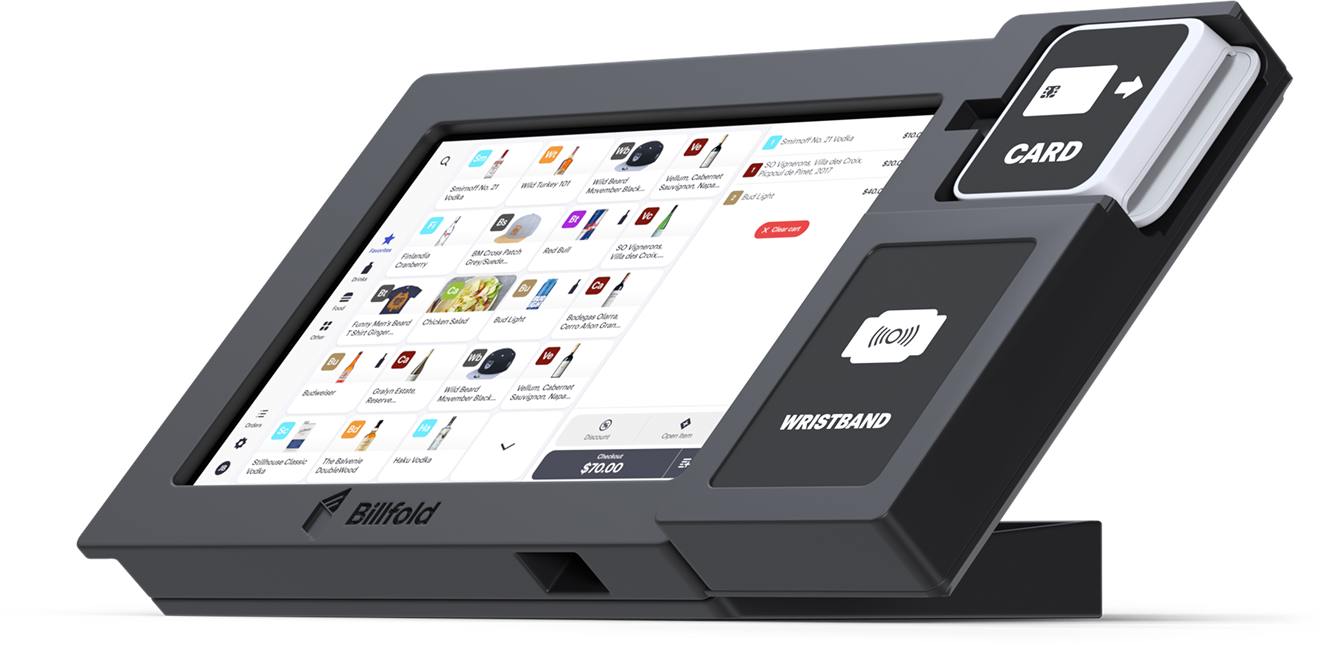Top Trends in Cashless Payment Solutions for 2026: What's Next?

The cashless payment revolution accelerates into 2026 with breakthrough technologies promising faster, more secure transactions across all industries.
- AI-powered fraud detection processing over 1 trillion data points in under 50 milliseconds to prevent sophisticated cyber attacks
- RFID and NFC systems dominating event environments with transaction speeds under 2 seconds, transforming customer experiences
- Blockchain and biometric technologies enabling new payment paradigms, with biometrics reaching $70.48 billion by 2032
- Embedded payment ecosystems reaching $59 billion in revenue by 2027, while digital wallets approach 5.2 billion users globally
Organizations must prioritize integrated payment infrastructures that seamlessly blend multiple technologies to meet evolving customer expectations while maintaining enterprise-level security.
Looking ahead to 2026, cashless payment solutions stand at the threshold of unprecedented innovation. As we move beyond the foundational changes of recent years, next-generation technologies are converging to create payment experiences that seemed like science fiction just a decade ago. Digital wallets are projected to reach 5.2 billion users by 2026, representing over 60% of the global population, setting the stage for even more dramatic transformations ahead.
The landscape entering 2026 reflects a fundamental shift from reactive payment processing to predictive, intelligent systems that anticipate user needs and prevent problems before they occur. This transformation extends far beyond simple convenience upgrades, addressing critical challenges around security, operational efficiency, and customer experience while creating entirely new revenue streams for forward-thinking organizations.
How Will AI-Powered Security Transform Payment Protection in 2026?
Artificial intelligence has emerged as the cornerstone of next-generation payment security, with organizations deploying machine learning algorithms to combat increasingly sophisticated fraud attempts. Mastercard's Decision Intelligence Pro uses generative AI to scan 1 trillion data points to predict in less than 50 milliseconds whether a transaction is likely to be genuine or not, boosting fraud protection rates by an average of 20% and as much as 300% in some instances.
The evolution beyond traditional rule-based systems represents a quantum leap in fraud prevention capability. Advanced AI systems now process massive datasets in real-time, identifying subtle patterns and anomalies that would be impossible for human analysts to detect. These systems continuously learn from each transaction attempt, building increasingly sophisticated models that adapt to emerging threats before they become widespread problems.
Machine learning algorithms also enhance legitimate transaction approval rates by dramatically reducing false positives that frustrate customers and impact revenue. By analyzing hundreds of variables simultaneously, these systems distinguish between genuine customer behavior and suspicious activity with unprecedented accuracy, creating smoother payment experiences for legitimate users while maintaining stringent security protocols.
The integration of generative AI enables payment systems to adapt continuously to emerging threats. Unlike static security protocols, AI-powered solutions evolve with each transaction, creating dynamic defense mechanisms that stay ahead of sophisticated fraud techniques. This proactive approach proves particularly valuable for organizations processing high transaction volumes or operating in high-risk industries where traditional security measures fall short.
What Makes Digital Wallets the Future of Consumer Payments?
Digital wallets have transcended their origins as simple payment storage tools to become comprehensive financial platforms integrating multiple services within unified interfaces. Wallet payments made up 54% of global e-commerce transaction volume in 2023, and are projected to reach 61% by 2026, while emerging competitors gain traction through specialized features and regional partnerships tailored to local market preferences.
The convenience factor driving adoption extends far beyond basic payment processing. Modern digital wallets incorporate loyalty programs, expense tracking, budgeting tools, and investment options within single applications. This convergence creates stickier customer relationships while generating valuable data insights that financial institutions and merchants leverage for competitive advantages.
Regional adoption patterns vary significantly across global markets, with different payment preferences and infrastructure capabilities driving localized growth strategies. These regional disparities create significant opportunities for payment providers to tailor solutions for specific markets and cultural preferences, particularly as cross-border functionality becomes increasingly important.
International travelers and global e-commerce customers increasingly expect seamless payment experiences regardless of geographic location or local payment preferences. Digital wallets that successfully bridge these gaps gain significant competitive advantages in the expanding global marketplace, where consistency and reliability across different regions determine user adoption rates.
The rise of "super apps" demonstrates how digital wallets are becoming central hubs for daily digital interactions. These platforms integrate payments with social networking, transportation, food delivery, and entertainment services, creating ecosystems that make switching to alternative providers increasingly difficult for consumers while generating comprehensive user data for service optimization.

Why Are RFID and NFC Systems Dominating Event Payment Solutions?
Event and entertainment venues represent the most dynamic growth segment for contactless payment technologies, with RFID payment solutions delivering transformative operational improvements and enhanced customer experiences that traditional payment methods simply cannot match.
- Revolutionary Speed and Efficiency Gains
Modern RFID systems process transactions in milliseconds, creating dramatic improvements in customer flow and vendor throughput. RFID wristbands complete transactions in under 2 seconds, enabling vendors to serve substantially more customers during peak periods while reducing wait times that frustrate attendees.
- Enhanced Security Through Advanced Encryption
Event RFID payment systems implement multiple security layers that surpass traditional payment methods in both sophistication and effectiveness. Each transaction generates unique authentication codes that cannot be replicated or reused, while advanced encryption protocols protect financial data throughout the payment process. These systems create secure environments even for large-scale outdoor events where traditional payment methods might be vulnerable to interference or fraud attempts.
- Comprehensive Analytics and Operational Insights
RFID payment technology reveals powerful data capabilities that extend far beyond simple payment processing. Organizers gain real-time visibility into attendee movement patterns, vendor performance metrics, and product popularity trends that inform immediate operational decisions and long-term strategic planning. This data-driven approach enables optimization of everything from staff allocation to inventory management.
- Seamless Integration with Event Management Systems
Advanced RFID platforms connect payment processing with access control, inventory management, and customer engagement tools through unified interfaces. This integration eliminates data silos while enabling sophisticated automation that reduces staffing requirements and improves customer experiences across all event touchpoints.

- Revenue Enhancement Through Increased Spending
Organizations implementing cashless payment systems report visitor spending increases that result from the frictionless payment experience encouraging impulse purchases while eliminating psychological barriers associated with cash transactions. The speed and convenience of RFID payments also enable vendors to capture sales during brief interaction windows that would be lost with slower payment methods.
- Network Independence and Reliability
Unlike mobile payment systems that depend on cellular connectivity, robust RFID implementations operate independently of network infrastructure. This capability proves essential for outdoor festivals, remote venues, or locations with unreliable internet access where traditional payment methods fail consistently, ensuring uninterrupted service even in challenging environments.
Which Emerging Technologies Will Reshape Payment Landscapes?
Blockchain technology has transitioned from experimental concept to practical implementation, with cryptocurrencies, stablecoins and tokenized assets moving from concept to commercialization, particularly as relates to their applicability to real-world assets. Central Bank Digital Currencies (CBDCs) represent the most significant development in this space, with multiple nations advancing from pilot programs to full implementation phases.
The integration of Internet of Things (IoT) devices creates payment scenarios that extend beyond traditional point-of-sale environments. Smart appliances, connected vehicles, and wearable devices increasingly incorporate payment capabilities that enable autonomous transactions based on user preferences and consumption patterns, creating seamless experiences where payments happen invisibly in the background.
Biometric authentication continues advancing toward mainstream adoption, with facial recognition, fingerprint scanning, and voice authentication eliminating the need for physical payment devices while providing enhanced security through inherent user characteristics that cannot be easily replicated or stolen.
Embedded finance could be worth up to $124 billion in 2025 for small businesses. These solutions integrate transaction capabilities directly into applications, websites, and devices, eliminating the need to redirect users to external payment processors while providing seamless experiences that increase conversion rates and customer satisfaction.
Voice-activated payments represent an emerging frontier that combines natural language processing with secure authentication protocols. As smart speakers and voice assistants become more prevalent, verbal payment commands will likely become routine for recurring purchases and subscription services, particularly in smart home environments where convenience and automation are priorities.
How Are Contactless and NFC Payment Systems Changing Commerce?
Near Field Communication technology has achieved critical mass adoption across diverse industry sectors. This dominance stems from NFC's combination of speed, security, and universal device compatibility that makes implementation straightforward for merchants and intuitive for consumers across diverse demographics and technical skill levels.
The infrastructure supporting NFC payment systems continues to expand rapidly across diverse industry sectors. Transportation systems, retail environments, healthcare facilities, and educational institutions increasingly deploy NFC-enabled payment terminals that accept multiple payment methods through unified interfaces, creating consistency in user experience regardless of location or industry.
Mobile device integration drives much of the growth in NFC adoption. 85% of NFC payments worldwide in 2023 were initiated via smartphones, reflecting their central role in the ecosystem. Wearable devices like smartwatches and fitness trackers provide additional convenience options for users who prefer hands-free payment experiences, particularly in active environments or situations where accessing a phone is impractical.
The speed advantages of NFC technology create tangible benefits for both merchants and customers. The average time for completing an NFC transaction dropped to 0.7 seconds, improving user experience while enabling merchants to process higher transaction volumes during peak periods. This efficiency becomes particularly valuable in high-traffic environments where queue length directly impacts customer satisfaction and purchase decisions.
What Technologies Will Drive Payment Innovation in 2026?
Looking toward 2026, several key technologies will converge to create payment experiences that seamlessly blend security, speed, and intelligence. Organizations implementing these solutions gain significant competitive advantages while meeting evolving customer expectations for frictionless interactions.
- Tokenization expansion beyond traditional card payments to include identity verification, loyalty programs, and access credentials within unified platforms
- Machine learning personalization that adapts payment interfaces and options based on individual user behavior patterns and preferences
- Quantum-resistant encryption preparing payment systems for the next generation of cybersecurity threats while maintaining current security standards
- Cross-platform interoperability enabling seamless transitions between different payment methods and devices within single transactions
- Predictive analytics that anticipate customer needs and pre-authorize likely transactions to eliminate friction at the point of sale
These technologies work synergistically to create payment ecosystems that extend far beyond simple transaction processing, becoming integral components of customer relationship management and business intelligence platforms.
How Should Organizations Future-Proof Their Cashless Payment Strategy?
Organizations planning payment system implementations must prioritize interoperability standards that ensure long-term flexibility and growth capacity. Proprietary systems that lock organizations into single-vendor ecosystems limit future upgrade options and integration possibilities, creating technical debt that becomes increasingly expensive to resolve over time.
Cloud-based architectures provide superior scalability compared to on-premise solutions, particularly for organizations operating multiple locations or planning expansion. These platforms enable rapid deployment of new features while centralizing security updates and compliance management, reducing operational overhead while improving system reliability and performance.
Comprehensive cashless solutions that support multiple payment methods within unified platforms offer the greatest future-proofing value. Rather than implementing separate systems for different payment types, integrated solutions adapt to changing customer preferences and emerging technologies without requiring complete infrastructure replacement or extensive staff retraining.
The importance of data analytics capabilities cannot be overstated in payment system selection. Organizations that leverage transaction data for operational optimization, customer segmentation, and predictive analytics gain significant competitive advantages over those treating payments as purely transactional utilities. This data becomes increasingly valuable as artificial intelligence and machine learning capabilities mature.
Staff training and change management represent critical success factors that many organizations underestimate. The most sophisticated payment technology fails without proper implementation planning that includes comprehensive training programs, ongoing support resources, and clear communication about benefits and changes to existing workflows.
Frequently Asked Questions
What are the main advantages of cashless payment solutions over traditional payment methods?
Cashless payment solutions offer significantly faster transaction processing, enhanced security through encryption and tokenization, reduced operational costs from eliminating cash handling, and valuable analytics data that enables better business decisions. Organizations typically see increased customer spending with cashless systems.
How secure are RFID and NFC payment systems compared to traditional credit cards?
RFID and NFC systems provide superior security through dynamic authentication codes, advanced encryption protocols, and tokenization that replaces sensitive financial data with unique transaction tokens. Unlike magnetic stripe cards that store static data, contactless systems generate unique codes for each transaction that cannot be replicated or reused maliciously.
What should organizations consider when choosing between different cashless payment technologies?
Key considerations include transaction volume requirements, network connectivity reliability, integration capabilities with existing systems, supported payment methods, real-time analytics features, security protocols, and total cost of ownership. Organizations should prioritize platforms that support multiple payment types and offer scalable cloud-based architectures.
How do AI-powered fraud detection systems improve payment security?
AI systems analyze massive datasets in real-time to identify suspicious patterns before transactions complete, processing up to 1 trillion data points in under 50 milliseconds. These systems continuously learn from each transaction attempt, adapting to new fraud techniques while reducing false positives that impact legitimate customers.
What role will biometric payments play in the future of cashless transactions?
Biometric payments using facial recognition, fingerprint scanning, and voice authentication eliminate the need for physical payment devices while providing enhanced security through inherent user characteristics. The contactless biometric market continues growing, driven by improved accuracy and user convenience.

Transform Your Payment Operations for 2026
The cashless payment landscape entering 2026 presents unprecedented opportunities for organizations ready to embrace technological innovation while prioritizing security and customer experience. From AI-powered fraud detection that processes transactions in milliseconds to RFID payment solutions that transform event experiences, the technologies driving change require strategic implementation rather than reactive adoption.
Success in this evolving environment demands integrated approaches that combine multiple payment methods, robust security protocols, and comprehensive analytics capabilities. Organizations that build flexible, scalable payment infrastructures position themselves to capitalize on emerging opportunities while adapting to rapidly changing customer expectations and market conditions.
The convergence of AI, blockchain, IoT, and biometric technologies creates payment ecosystems that extend far beyond simple transaction processing. These integrated platforms become central nervous systems for entire operations, connecting everything from inventory management to customer engagement strategies while generating valuable insights that drive business growth.
Forward-thinking organizations recognize that payment system selection represents strategic infrastructure decisions with long-term competitive implications. The choices made today determine operational efficiency, customer satisfaction, and growth potential for years to come as the industry continues its rapid evolution toward intelligent, predictive payment experiences.
Ready to transform your payment operations with cutting-edge technology that drives both efficiency and customer satisfaction? Discover how Billfold's comprehensive payment solutions can revolutionize your business operations and get started today.

